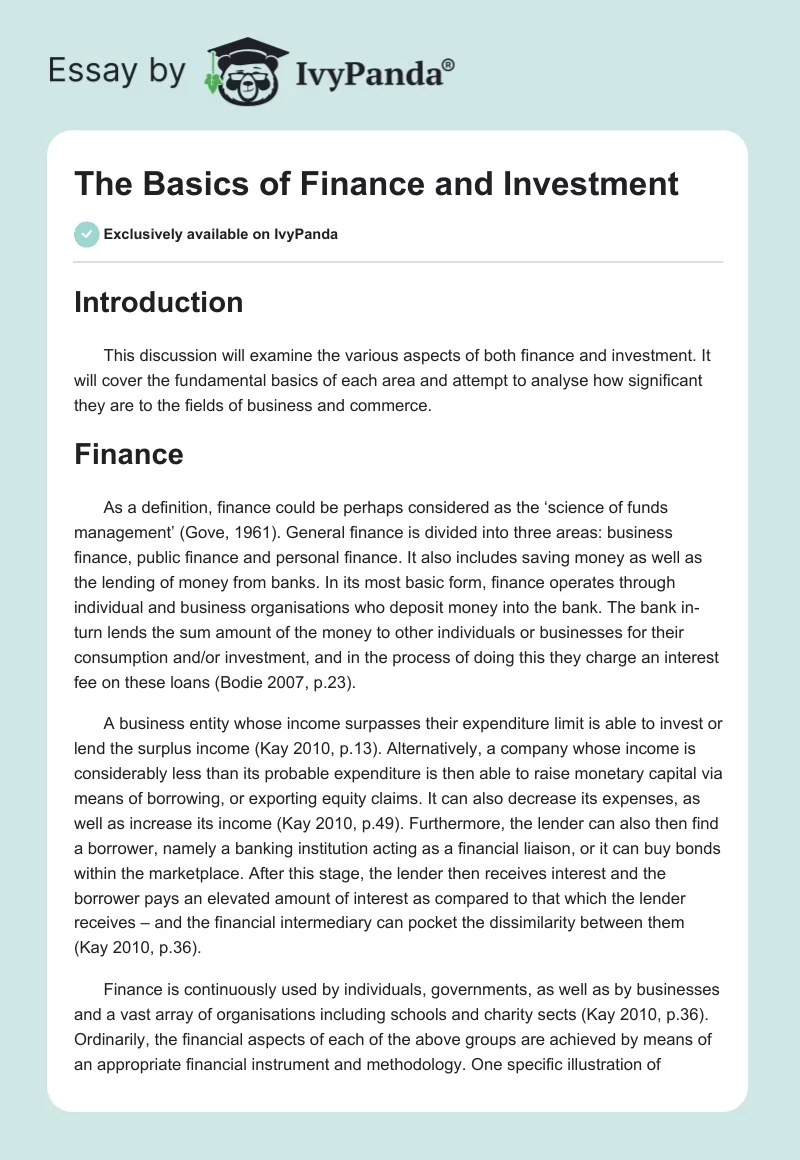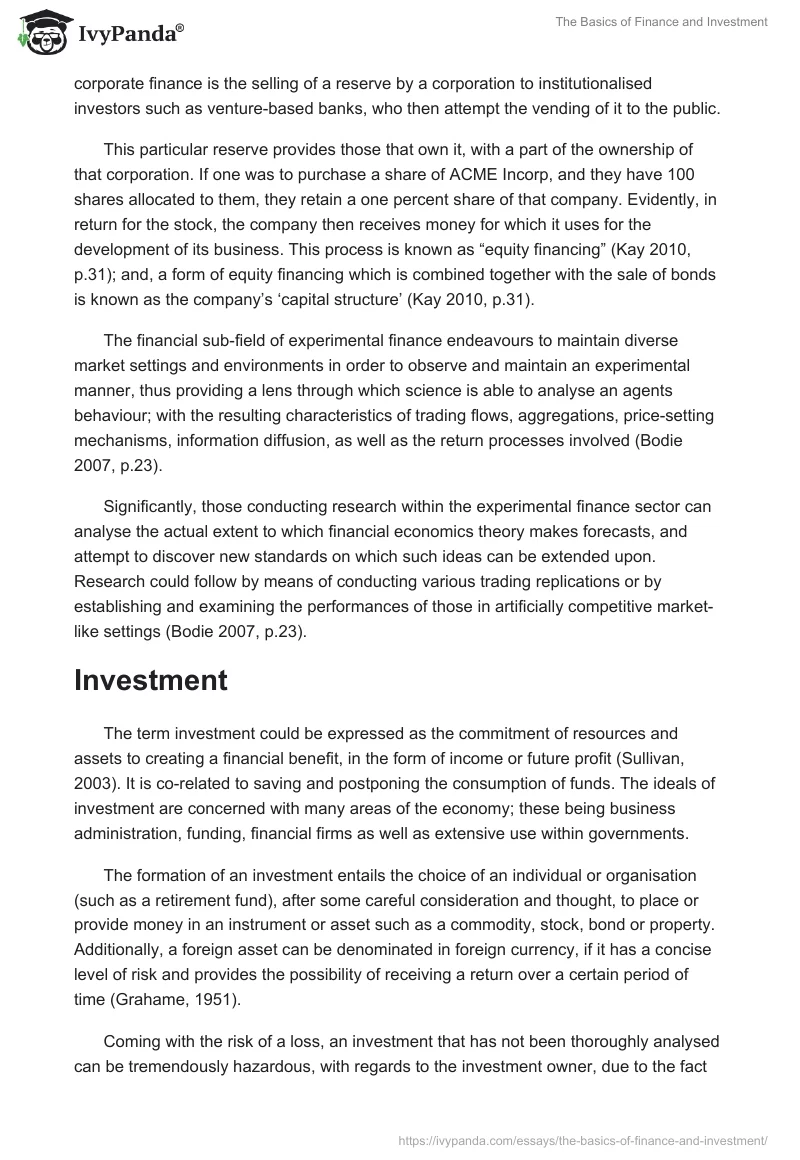Introduction
This discussion will examine the various aspects of both finance and investment. It will cover the fundamental basics of each area and attempt to analyse how significant they are to the fields of business and commerce.
Finance
As a definition, finance could be perhaps considered as the ‘science of funds management’ (Gove, 1961). General finance is divided into three areas: business finance, public finance and personal finance. It also includes saving money as well as the lending of money from banks. In its most basic form, finance operates through individual and business organisations who deposit money into the bank. The bank in-turn lends the sum amount of the money to other individuals or businesses for their consumption and/or investment, and in the process of doing this they charge an interest fee on these loans (Bodie 2007, p.23).
A business entity whose income surpasses their expenditure limit is able to invest or lend the surplus income (Kay 2010, p.13). Alternatively, a company whose income is considerably less than its probable expenditure is then able to raise monetary capital via means of borrowing, or exporting equity claims. It can also decrease its expenses, as well as increase its income (Kay 2010, p.49). Furthermore, the lender can also then find a borrower, namely a banking institution acting as a financial liaison, or it can buy bonds within the marketplace. After this stage, the lender then receives interest and the borrower pays an elevated amount of interest as compared to that which the lender receives – and the financial intermediary can pocket the dissimilarity between them (Kay 2010, p.36).
Finance is continuously used by individuals, governments, as well as by businesses and a vast array of organisations including schools and charity sects (Kay 2010, p.36). Ordinarily, the financial aspects of each of the above groups are achieved by means of an appropriate financial instrument and methodology. One specific illustration of corporate finance is the selling of a reserve by a corporation to institutionalised investors such as venture-based banks, who then attempt the vending of it to the public.
This particular reserve provides those that own it, with a part of the ownership of that corporation. If one was to purchase a share of ACME Incorp, and they have 100 shares allocated to them, they retain a one percent share of that company. Evidently, in return for the stock, the company then receives money for which it uses for the development of its business. This process is known as “equity financing” (Kay 2010, p.31); and, a form of equity financing which is combined together with the sale of bonds is known as the company’s ‘capital structure’ (Kay 2010, p.31).
The financial sub-field of experimental finance endeavours to maintain diverse market settings and environments in order to observe and maintain an experimental manner, thus providing a lens through which science is able to analyse an agents behaviour; with the resulting characteristics of trading flows, aggregations, price-setting mechanisms, information diffusion, as well as the return processes involved (Bodie 2007, p.23).
Significantly, those conducting research within the experimental finance sector can analyse the actual extent to which financial economics theory makes forecasts, and attempt to discover new standards on which such ideas can be extended upon. Research could follow by means of conducting various trading replications or by establishing and examining the performances of those in artificially competitive market-like settings (Bodie 2007, p.23).
Investment
The term investment could be expressed as the commitment of resources and assets to creating a financial benefit, in the form of income or future profit (Sullivan, 2003). It is co-related to saving and postponing the consumption of funds. The ideals of investment are concerned with many areas of the economy; these being business administration, funding, financial firms as well as extensive use within governments.
The formation of an investment entails the choice of an individual or organisation (such as a retirement fund), after some careful consideration and thought, to place or provide money in an instrument or asset such as a commodity, stock, bond or property. Additionally, a foreign asset can be denominated in foreign currency, if it has a concise level of risk and provides the possibility of receiving a return over a certain period of time (Grahame, 1951).
Coming with the risk of a loss, an investment that has not been thoroughly analysed can be tremendously hazardous, with regards to the investment owner, due to the fact that the possibility of losing money is not within the control of the owner (Merton 2005, p.1). The differentiation between investment and speculation can be relatively understated. It all depends on the mind of the investment owner, and whether the purpose is for providing the resource to someone else for economic purposes or not (Grahame, 1951).
Rather than store the goods which are produced, or their monetary equivalent, a wise investor should choose to use that good either to generate a resilient consumer or producer good, or to lend the original saved good to another as a substitute for either interest – or as an allocation of the profit (Merton 2005, p.1). In the beginning, the individual will need to create effective consumer goods, hopeful that the services from these goods will assist in the improvement of their financial situation.
In the second instance, however, the individual must become an entrepreneur using the resources to produce further goods and services for other individuals – with the concluding aspiration of a profitable sale (Merton 2005, p.1). Subsequently, the third case illustrates someone who then lends, and the fourth one describes the financier in a share of the company. Within each of these instances, the purchaser must attain an investment or asset that could be considered durable. And, as time passes, with the price and interest rate changing, the value of the asset as well as the liability also changes too (Merton 2005, p.1).
Conclusion
The value of an asset is of utmost importance (Mai 1997, p.77). Typically, the asset is purchase; or, a deposit is made into a banking account with the hope that there will be a future return or some sort of interest gain from it. The actual word originates from the Latin “vestis” which means garment (Mai 1997, p.79). It refers to the act of putting money or other resources into the pockets of others, and the basic meaning of the term relates to the holding of an asset, in order to have at least some recurring or capital expansion. Additionally, it is the asset which is expected to give returns without the requirements of any exertion.
The term “investment” is used considerably different in the finance and economic spectrums (Mai 1997, p.81). Economists often refer to a real investment (such as a vehicle or piece of property), while financial economists consider a financial asset, such as money that is put into the bank or a market, which may then be used to purchase a ‘real’ asset (Mai 1997, p.79).
References
Bodie, Z 2007 “Making Investment Choices as Simple as Possible” Financial Analysts Journal.
Gove, P. et al 1961. Finance. Webster’s Third New International Dictionary of the English Language Unabridged. Springfield, Massachusetts: G. & C. Merriam Company.
Grahame, B 1951. Security Analysis. McGraw-Hill Book Company.
Kay, F 2010, Everything You Need to Know About Health, Property, Investment, Leisure, Work, Pensions and Tax, 24th ed. Kogan Page Ltd.
Mai, B 1997, Finance and Investments, The Reference Librarian, West Lafayette: IN, Vol.27, Issue.57, pages 77-83.
Merton, R 2005 “The Design of Financial Systems: Towards a Synthesis of Function and Structure,” Journal of Investment Management, vol 3, no. 1, p.1.
Sullivan, A 2003, Economics: Principles in Action, Pearson Prentice Hall, Upper Saddle River: NJ.


